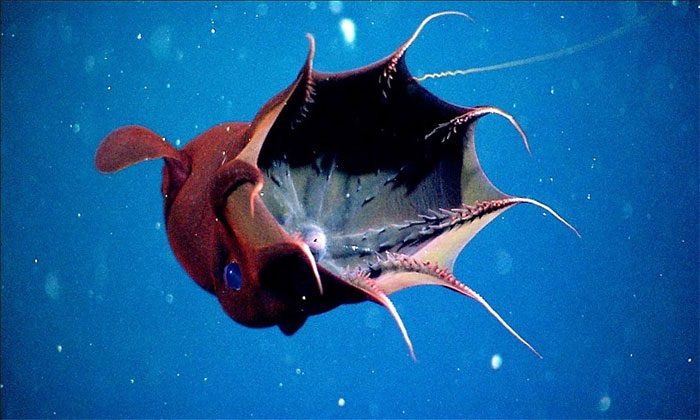The vampire squid has remained nearly unchanged from its ancestors that lived hundreds of millions of years ago and is often referred to by scientists as a “living fossil.”
The vampire squid hunts in the deep sea.
Known scientifically as Vampyroteuthis infernalis, which translates to “vampire squid from hell” in Latin, this creature lives primarily in the deep sea. It has a dark red body and a cloak-like webbing connecting its eight tentacles. Despite its name and appearance, it is neither a squid nor an octopus but belongs to a distinct order of cephalopods. It is the only known living member of the Vampyromorphida order.
According to Bruce Robison, a scientist at the Monterey Bay Aquarium Research Institute, the vampire squid represents ancient cephalopods that predate the split into octopuses and squids. It possesses eight tentacles and two long, slender filaments not found in other cephalopods. These filaments are used to collect food particles. The webbing between the tentacles resembles an umbrella. The inner surface of the vampire squid’s tentacles is lined with suckers.

The vampire squid prefers deep, dark, and cold environments.
“Even when the vampire squid is the target of a research project, we can never be sure that we will find a specimen when needed. They are solitary creatures and sparsely distributed across their vast habitats,” Robison stated.
The vampire squid thrives in deep, dark, and cold environments, typically at depths of 610 to 914 meters below the surface, where oxygen levels are quite low. It has several adaptations that suit it well to this environment, including neutral buoyancy and a low metabolic rate, which help reduce the need for muscle development for movement and conserve energy. Its dark appearance helps it evade the gaze of predators, minimizing the need for rapid escape. The vampire squid is perfectly adapted to low temperatures and reduced oxygen levels due to its slow metabolic rate, lethargic behavior, and specialized oxygen collection system from water.
This squid primarily survives by consuming “marine snow,” a mixture of organic debris, dead animals, feces, and mucus that sinks to the ocean floor. This feeding method has never been recorded in other cephalopods. One of the few predators of the vampire squid is the toothed whale, a species that is not affected by the low oxygen concentrations at the depths where it resides.


















































